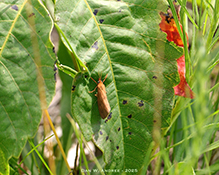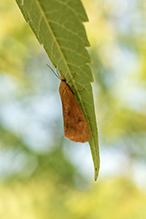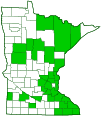orange virbia moth
(Virbia aurantiaca)
Conservation • Description • Habitat • Ecology • Distribution • Taxonomy
|
|
||||||||||||||||||
Description |
Orange virbia moth, formerly known as orange holomelina moth, is a common, colorful, relatively small, tiger moth. It occurs in the United States and southern Canada east of the Rocky Mountains. It also occurs in Mexico. It is common in Minnesota. The specific hosts for the larvae are unknown, but they have been reported on dandelion, plantain, common lambsquarters, corn, and grasses. Adults do not feed. They are found from May through September, low on vegetation, in most open and forested habitats and in gardens. Adults are ⅜″ to 9⁄16″ (10 to 14 mm) in length and have a ¾″ to ⅞″ (19 to 23 mm) wingspan. Size for moths is sometimes given in terms of forewing length. The forewing length of the male is ⅜″ (10 mm), that of the female is ⅜″ (9.7 mm). The body is slender. Adults are highly variable in appearance, and this has resulted in several species being named based on observable characteristics. The forewing of the female is pale orange, clay colored, cinnamon, or salmon colored. There is a faint, dark, discal spot and sometimes a faint, dark, subterminal band. The forewing of the male is dark clay colored, brown, or cinnamon, but otherwise similar to that of the female. Both sexes usually have no obvious markings. The hindwing of both sexes is orange, peach red, or pink. There is a small, dark, discal spot; and a broad, dark band on the outer margin. The band is often incomplete, sometimes more or less broken into separate spots. It is more complete, sharply defined, and darker, sometimes black, on the female. Virbia caterpillars are grayish or brownish with a conspicuous, broad, pale stripe above. Clusters of black spines mixed with some white spines rise from black warts on each segment of the thorax and abdomen. Identification of an individual to the species level requires rearing it to adulthood. |
Size |
Total length: ⅜″ to 9⁄16″ (10 to 14 mm) Wingspan: ¾″ to ⅞″ (19 to 23 mm) |
Similar Species |
Habitat |
Open areas, forests, and gardens |
Ecology |
Season |
Two generations per year: May through September |
Behavior |
Adults are active both day and night. They rest with their wings tightly closed. |
Life Cycle |
|
Larva Food |
Leaves of low growing plants |
Adult Food |
Adults do not feed |
Distribution |
||
|
Sources 21, 24, 27, 29, 30, 75, 82, 83. Biodiversity occurrence data published by: Minnesota Biodiversity Atlas (accessed through the Minnesota Biodiversity Atlas Portal, bellatlas.umn.edu, 7/12/2025). |
|
| 7/12/2025 | ||
Occurrence |
||
Common |
||
Taxonomy |
|
Order |
|
Superfamily |
Noctuoidea (Owlet Moths and Allies) |
Family |
Erebidae (Underwing, Tiger, Tussock, and Allied Moths) |
Subfamily |
Arctiinae (tiger moths and allies) |
Tribe |
Arctiini (tiger moths) |
Subtribe |
Spilosomina |
Genus |
Virbia (virbia moths) |
Family Genus |
|
Subordinate Taxa |
|
|
|
Synonyms |
|
Arctia bimaculata Crocota bimaculata Crocota brevicornis Crocota choriona Eubaphe aurantiaca Holomelina aurantiaca |
|
Common Names |
|
orange holomelina orange holomelina moth orange virbia moth |
|
Visitor Photos |
||
Share your photo of this insect. |
||
This button not working for you? |
||
Dan W. Andree |
 |
Orange Virbia Moth on Western Poison Ivy |
Greg Watson |
 |
… possibly an Orange Virbia Moth. Not a great picture because the moth didn’t give me a lot of time to get decent ones. I took the photo near the Red Apple Drive trailhead for Eagles Bluff Park in La Crescent. |
MinnesotaSeasons.com Photos |
||
|
||
|

Slideshows |
|

Visitor Videos |
||
Share your video of this insect. |
||
This button not working for you? |
||
|
Other Videos |
||
Orange Virbia Moth 1 |
About
Jul 16, 2023 rofile of an Orange Virbia Moth. |
Orange Virbia moth flies by Carolina Mantis in slow motion |
About
Sep 2, 2019 Orange Virbia moth flies by Carolina Mantis in slow motion. Both insects were attracted to a blacklight after dark. |

Visitor Sightings |
||
Report a sighting of this insect. |
||
This button not working for you? |
||
| Dan W. Andree July 2025 |
Location: Frenchman’s Bluff SNA Orange Virbia Moth on Western Poison Ivy |
 |
MinnesotaSeasons.com Sightings |
||
|

Created: 10/10/2023 Last Updated: © MinnesotaSeasons.com. All rights reserved. |

